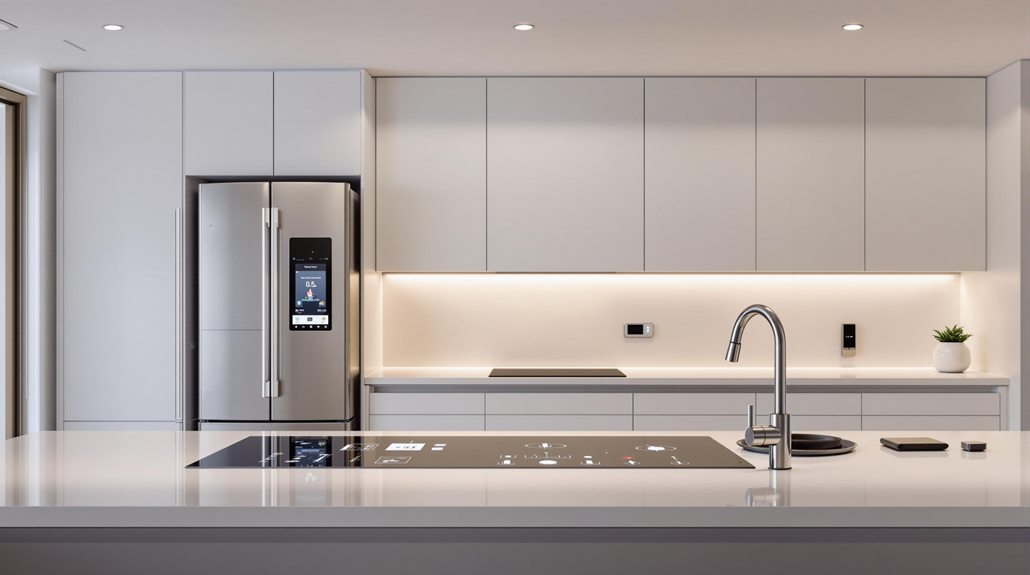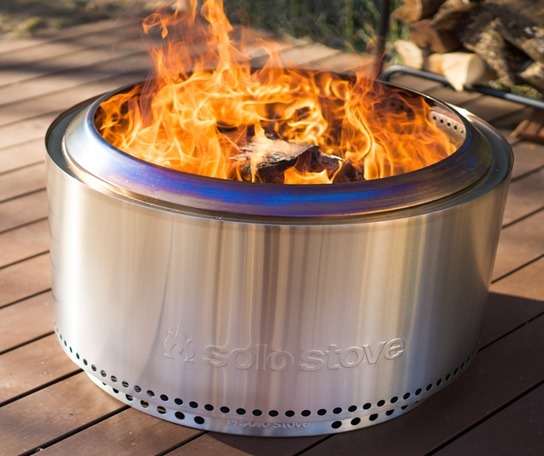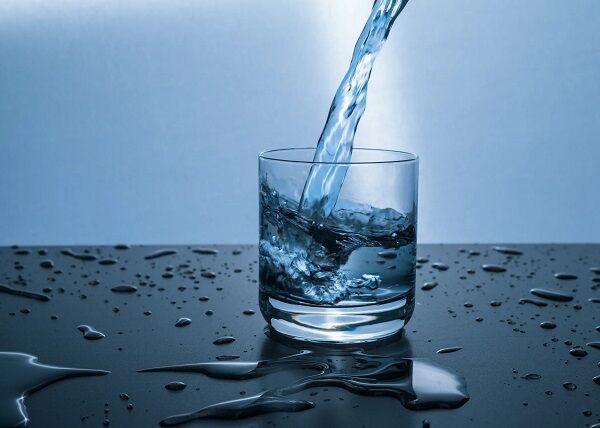What Is Professional Cookware Made Of?
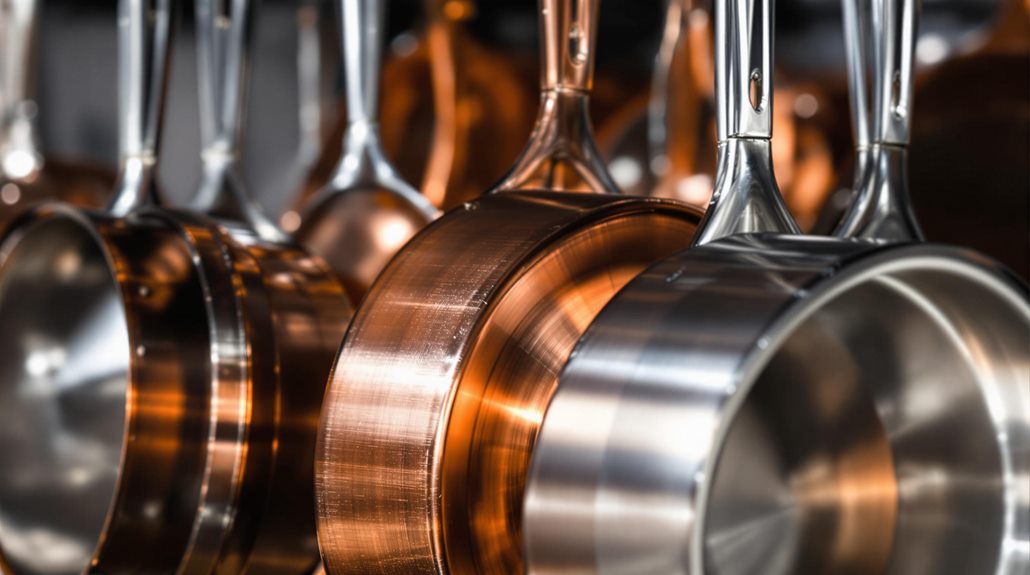
Professional cookware is primarily made from stainless steel, copper, aluminum, carbon steel, and cast iron. You'll find that high-end cookware often features multi-layer construction, like tri-ply or five-ply materials, which combine different metals for ideal performance. Stainless steel with aluminum or copper cores provides durability and excellent heat distribution, while cast iron excels at heat retention. Copper offers the fastest and most even heating, making it a chef favorite. Carbon steel develops a natural non-stick surface through seasoning. Understanding these materials' unique properties will help you make informed choices for your kitchen needs.
Understanding Professional Kitchen Materials
For dishes requiring consistent cooking temperatures, cast iron cookware and carbon steel cookware shine with their impressive heat retention properties. You'll uncover that both materials develop a natural non-stick surface over time through proper seasoning. Aluminum cookware offers a lightweight alternative with excellent heat conductivity, which is why it's often sandwiched between layers of stainless steel in high-end cookware.
When you're working with delicate foods or need easy cleanup, non-stick coating options provide a practical solution, though they'll typically need replacement more frequently than metal alternatives. Each material serves specific purposes in professional kitchens, and you'll often find chefs using a combination of these materials to achieve ideal cooking results based on different cooking techniques and requirements.
Common Types of Cookware Metal
Professional kitchens rely on specific metals for their unique cooking properties and performance characteristics. You'll find that stainless steel, enhanced with chromium and nickel (particularly in 18/10 grade), offers exceptional durability and acid-resistant properties, making it a staple in commercial kitchens.
When it comes to heat conduction, copper stands out as the superior choice, providing rapid and even heat distribution throughout your cookware. However, you'll need to safeguard it's lining with non-reactive metals like stainless steel or tin to prevent unwanted reactions with food. Aluminum follows as the second-best heat conductor, though you'll want to be cautious with acidic ingredients as they can react with the metal.
For versatility, you'll find carbon steel offers good heat conduction while developing a natural nonstick surface through proper seasoning. Cast iron, while not the best conductor, excels in heat retention, making it ideal for specific cooking techniques. If you're looking for healthier cooking options, modern nonstick cookware allows you to use minimal oil, though you should note that their effectiveness may diminish over time. Each metal brings distinct advantages to your kitchen, and understanding these properties helps you choose the right tool for each cooking task.
Heat Distribution Across Materials
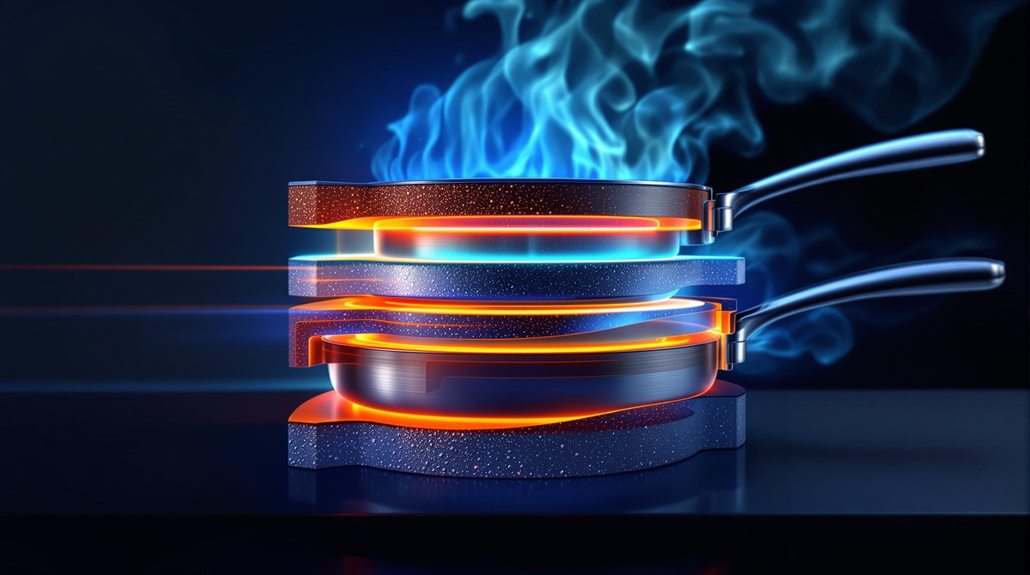
Heat distribution plays an essential role in determining your cookware's performance and cooking results. Professional chefs know that different materials conduct and retain heat in unique ways, which directly impacts your cooking outcomes. When you're looking for superior heat conductivity, copper leads the pack, followed closely by aluminum. These materials guarantee your food cooks evenly without hot spots.
Stainless Steel Cookware with aluminum or copper cores gives you the best of both worlds - durability and excellent heat distribution. Cast iron pans excel at heat retention, making them perfect for slow-cooking and maintaining consistent temperatures. Copper cookware offers the fastest and most even heating, which is why it's a favorite among professional chefs. Carbon steel provides balanced heat distribution, positioning itself as a versatile material for various cooking methods.
If you're considering what material makes stainless steel a popular choice, it's the combination of its heat distribution capabilities when paired with conductive cores. While pure stainless steel isn't the best conductor, manufacturers often combine it with aluminum or copper to improve its performance. This makes stainless steel cookware an excellent choice for both home cooks and professionals who need reliable heat distribution.
Multi-Layer Construction Benefits
Through innovative engineering, multi-layer cookware construction combines different metals to create the ultimate cooking vessel. When you're cooking with tri-ply or five-ply cookware, you'll experience superior heat conductivity and even heat distribution that single-layer pots and pans simply can't match. The strategic layering of materials like stainless steel with an aluminum core or copper core guarantees you get the best properties of each metal in one piece.
The benefits of multi-layer construction are particularly evident in tri-ply cookware, which sandwiches an aluminum core between stainless steel layers. You'll notice faster heat response and better temperature control while maintaining the durability and corrosion resistance of stainless steel. If you're looking for even more advanced heat performance, five-ply cookware offers additional layers of aluminum or copper, virtually eliminating hot spots and providing unmatched temperature control. This sophisticated design also improves energy efficiency, as the heat distributes more evenly across the cooking surface. Professional chefs prefer this construction because it delivers consistent results and superior cooking performance, making it worth the investment for serious home cooks who demand restaurant-quality results.
Choosing Restaurant-Grade Cookware
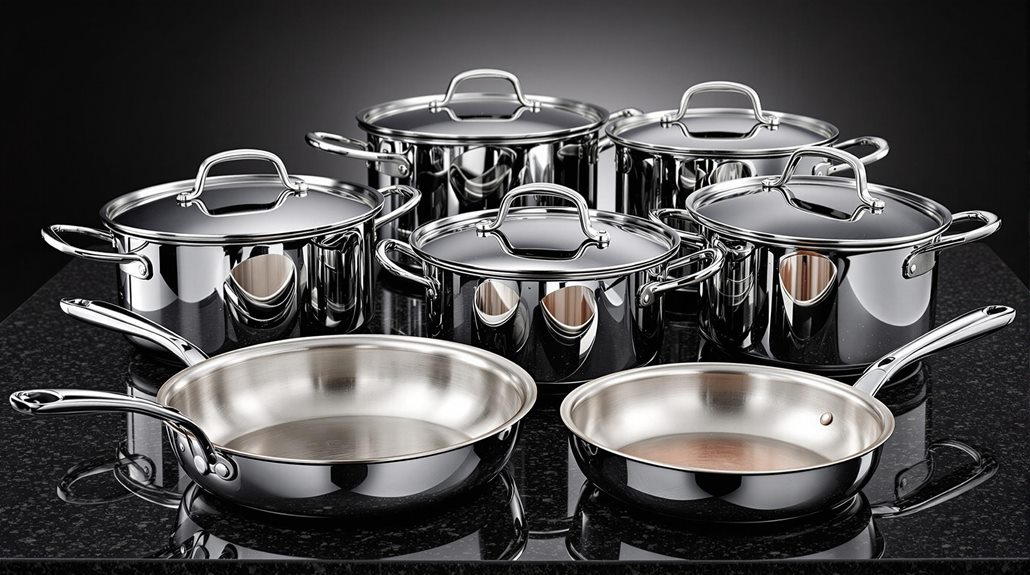
When selecting restaurant-grade cookware, understanding material composition becomes the foundation of your decision-making process. You'll need to weigh the unique properties of each material to match your cooking style and kitchen demands. Professional-grade cookware stands out for its superior heat conductivity, durability, and performance under intense use.
Consider these essential factors when choosing your cookware:
- Stainless steel pieces, particularly 18/10 grade, offer exceptional corrosion resistance and oven-safe capabilities, making them versatile for various cooking techniques
- Cast iron provides unmatched heat retention and develops natural nonstick properties, perfect for searing and slow-cooking dishes
- Copper cookware delivers precise temperature control and superior heat distribution, ideal for temperature-sensitive preparations
- Clad cookware combines multiple materials' benefits, offering the durability of stainless steel with enhanced heat conductivity
You'll find that investing in high-quality materials pays off in longevity and cooking results. When you're equipping a professional kitchen, focus on pieces that can withstand daily rigors while maintaining consistent performance. The right combination of these materials will give you a versatile, reliable cookware collection that meets professional standards.
Maintenance Requirements By Material
Maintenance [SKILL] can make or break your professional cookware's longevity. This is why chefs prefer stainless steel pans, as they require minimal upkeep - just warm soapy water and a soft cloth, followed by thorough drying. Stainless steel frying pans have become the go-to cookware material in professional kitchens due to their hassle-free maintenance.
Each Type of Cookware demands different care routines. Cast iron and carbon steel cookware often need regular seasoning to maintain their cooking surface and prevent rust. Chefs Use these materials knowing they'll need to oil them regularly and store them in dry conditions. When it comes to copper cookware, you'll need to invest time in polishing to preserve its characteristic shine and prevent tarnishing.
While nonstick cookware might seem convenient, its Pros and Cons include easy cleaning but limited durability. You'll need to hand-wash these pans and avoid high-heat cooking to prevent coating degradation. Professional kitchens using layers of stainless steel cookware benefit from its durability and straightforward maintenance, making it the preferred choice for demanding commercial environments.
Professional Cookware Brands Guide
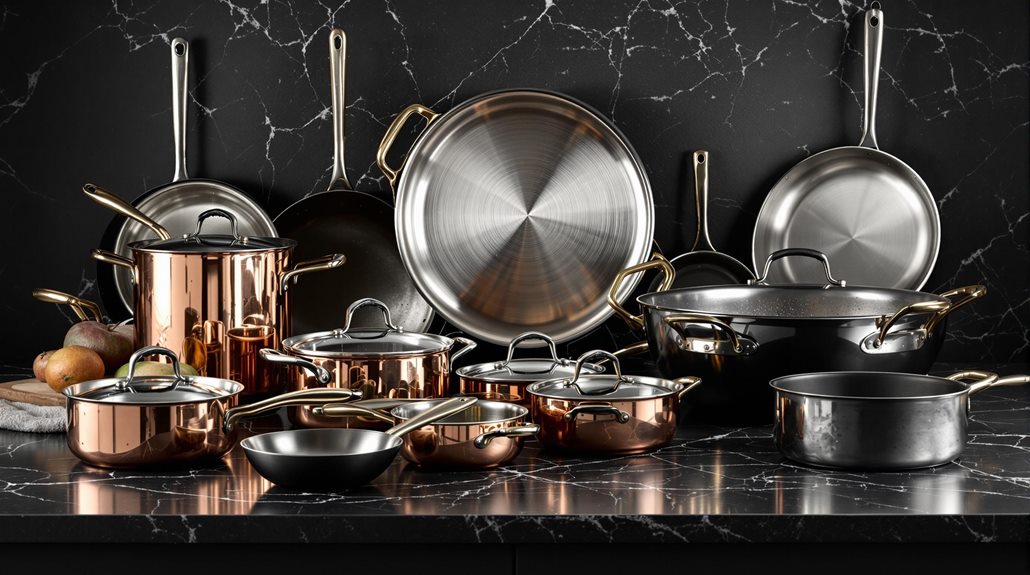
Leading professional cookware brands stand out for their distinctive manufacturing processes and specialized materials. You'll find that each brand excels in specific areas, from Le Creuset's renowned enameled cast iron pieces to All-Clad's premium stainless steel with tri-ply construction. When selecting professional cookware, consider how different materials affect heat conductivity and distribution in your cooking.
- Le Creuset dominates the enameled cast iron category, offering superior heat retention and even distribution, perfect for slow-cooking and braising
- All-Clad's tri-ply construction combines stainless steel with aluminum cores, providing exceptional durability and consistent heating across their non-stick and traditional surfaces
- Mauviel's copper cookware provides unmatched heat conductivity and precise temperature control, making it ideal for demanding cooking techniques
- Staub's Dutch ovens feature innovative self-basting spikes and durable construction, while Misen offers professional-grade performance at more accessible price points
Each brand's manufacturing approach reflects their knowledge with specific materials. Whether you're seeking the thermal properties of copper, the versatility of stainless steel, or the traditional benefits of cast iron, these manufacturers have refined their processes to furnish superior cooking performance.


